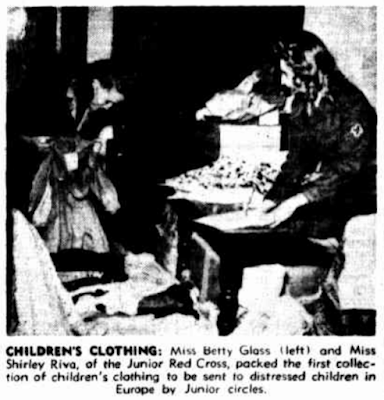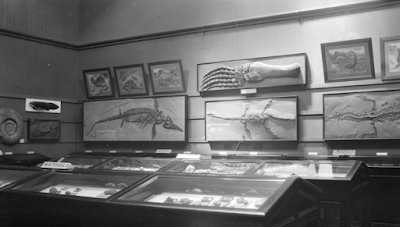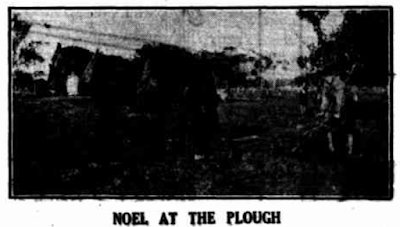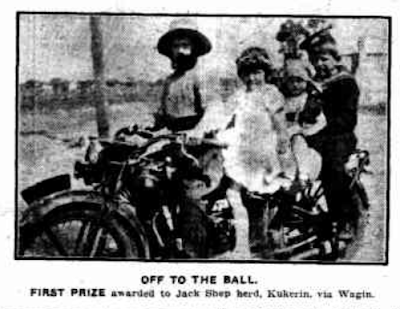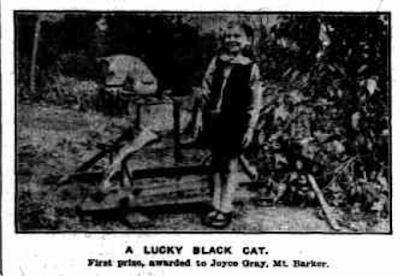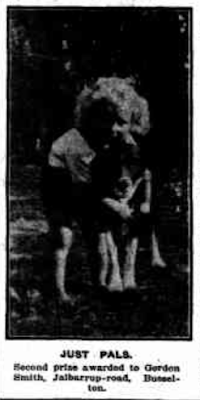Auntie Kitty And The Children Of Subiaco...(1930).
During the early years the children of Western Australia and Subiaco wrote letters to children's pages in the local newspapers, not only to the Daily News newspaper but other newspapers such as The Sunday Times and the WA Catholic Record.
The children asked to become members of clubs the newspapers formed, entered competitions to win prizes, wrote letters, shared their creative work and aspects of themselves and their lives as children growing up in suburbs such as Subiaco and country Western Australia.
The local Western Australian newspaper, The Sunday Times children's page was edited by Auntie Kitty. The page contained letters from children who shared aspects of their lives. While the letters were acknowledged, not all of them were published and there do not seem to be any responses from Auntie Kitty. The page also included competitions, children's creative work, and a range of activities and stories and poems the editor thought children may like to do in their free time and a cookery corner. The children's birthdays were acknowledged and published on the page by Auntie Kitty.
The children shared many insights about themselves and their activities as children growing up in the early years of Western Australia. For example, one young person Gwenyth Lewis of Subiaco Road, Subiaco wrote about going on a trip with Mrs Joyner to Fairbridge Farm in Pinjarra with the Little Citizens League. Mrs Joyner and some of her work with the Little Citizen's League in Subiaco is published in previous posts on this blog. Some of the young people such as Margery Owens of Hensmen Road, Subiaco I have met before who wrote to Auntie Nell at the Daily News newspaper. Her letters and story are also contained in previous posts on this blog. The only problem is the letters published do not contain the age of the children who wrote them unless they state it their letters and are not classified according to age groups such as in the Daily News newspaper.
During the 1920's and 1930's the children's letters show that photography was becoming one of their favourite pass times. One young person Gilbert Hicks from Subiaco shared in a letter one of his favourite pass times was taking and developing photographs. Throughout 1930, The Sunday Times newspaper ran a competition which encouraged children to take photographs and send them into the paper for publication. The photographs published provide a wonderful insight into the lives of children by children. The competition information provided insisted the photographs be taken by children. The results were published monthly. This competition is the subject of the next post.
"...Would you like to win a camera? Can you take good snapshots? If you can. enter for our Snapshot Contest, which will be held monthly. We are offering a fine CAMERA for the best snap sent in and a very useful WRITER'S COMPANION tor the next best snap. See what you can do. Snap your friends or your pets, and see if you can win one of these lovely cameras. Remember, you must take the snap yourself and you must write your full name and address on the back. Also write on the back of the snap the name or names of the people or pets snapped. Snaps must be addressed to Auntie Kitty "The Sunday Times." Perth, and the words "Snapshot Contest" written on the envelope. Snaps must reach the office by Monday.. and will he judged on the following day. We reserve the right to publish any snap entered..."
Throughout 1930 many children wrote to Auntie Kitty. Letters from the children of Subiaco were published nearly every month.
The articles and photographs are from Trove, the database of the National Library of Australia.
Dear Auntie Kitty,- I have never written to you before, but I would like, to join your happy band. I have read the Children's Column ever, since, we came back from Melbourne. I won two scholarships for drawing in the, East, and I am learning painting here. I am also fond of reading, and have a nice bookcase with 120 books. I also have a cat 14 years old and a pet white cockatoo, whom we call Corry. He is an affectionate little thing, and very tame. He is never in his cage, and talks a good deal. I remain, your would be niece. MAVIS HANCOCK, 76 Gloster-street, Subiaco. (The Sunday Times, 5 January, 1930).
Dear Auntie Kitty, - For many weeks now I have been an interested reader of the Children's Page in "The Sunday Times", and was very much surprised at your long column of correspondence and I hope you will enrol me. I am nearly fourteen and am in the seventh class at school. Several of my school chums also write to you. I have noticed though, their letters have not been published. Not long ago. Mrs. Joyner, of Rheola-street West Perth, arranged a charabanc trip up to Fairbridge Farm, Pinjarra, for the Little Citizen's League to see their little friends to whom they write constantly. We spent a delightful day up there amongst the hills where it is very cool and refreshing. I have entered for the new year puzzles and think they are correct. They were fairly difficult this week, don't you think? Well, hoping you will enrol me as one of your many nieces, I will now close with heaps of love from your niece GWENYTH LEWIS, 104 Subiaco-road. Subiaco. (The Sunday Times, 19 January, 1930).
Dear Auntie Kitty,- I have not written to you for a year or more, but I will try to write fairly regularly now. I will send in some stories later on. You see, I am rather keen on writing and spend a good deal of my time making up stories. At present, however, we are busy tidying the house up, for we have been away in Europe for about nine months. I will tell you all about it in another letter. I have got a camera and will send in a photo of myself later on. The camera is a No. 2 Brownie and I have taken several interesting snaps although I only got it from London two or three months ago. I am enclosing the answers to the puzzles. I hope they are correct and that I win a prize. Your affectionate niece, MARGERY OWENS, 228 Hensman-road, Subiaco. (The Sunday Times, 26 January 1930).
Dear Auntie Kitty - I suppose you think I have forgotten you, but that is not so. I still read the Children's Budget and enjoy it very much. I thought the Christmas number was very nice. I cut out all the stories and riddles and jokes and pasted them into a book. It is my birthday next Sunday. I am having a nice cake and a few of my friends to tea. I will be 14 years of age. I am sending in a few riddles which I hope to see in print I will close now, sending my love to you. I remain, your, loving nephew, JIM LUSTED. 330 Churchill -avenue Subiaco (The Sunday Times, 26 January 1930).
Dear Auntie Kitty, - As this is the first time I have written to you, I would be pleased if you would enrol me as one of your nieces. I am ten years of age and I go to St. Joseph's Convent, Subiaco. I am In third class at school, and like it very much. I am entering for the Seaside Competition, and I hope I am successful in winning a prize. We get "The Sunday Times" every week and I rush for the Children's Page, which I enjoy reading very much. I will bring my letter to a close as I nave no more news. I remain, your would be niece, LILLIAN, SPENCER, 166 Barker-road, Subiaco. (The Sunday Times, 23 February 1930).
Dear Auntie Kitty - I have written to you before and as my letter did not appear in print I would like very much to have this published. I would like to become one of your nieces and also would enjoy corresponding with a pen friend about eleven years old. I go to the Subiaco State school. After a vacation of six weeks I went back to school to find I had been passed into the fifth class. I stayed at the Sandycroft Hostel, North Beach, during the vacation and enjoyed myself immensely. - Your loving niece, HILDA GALLOWAY, 8 Kings-road, Subiaco. (The Sunday Times, 9 March 1930).
Dear Auntie Kitty,- I tried very hard to solve the clues competition, but was unsuccessful so I am sending you the Maze Puzzle in this letter. It is no use my sending you the snaps for the competition as I have not camera of my own but I will send you a few for the, page. I am growing a few sweet peas in my garden now and I hope they will do well. I enjoy reading the stories printed in the "Children's Page" and will end one in myself one day. I am in Class V at school and am getting on fairly well, although I am behind the rest in arithmetic, as I have missed the other six months. I am afraid must finish this short letter now as I have another letter to write. Your loving niece. MARGERY OWENS, 228 Hensman-road, Subiaco. (The Sunday Times, 6 April 1930).
Dear Auntie Kitty,- I am writing to you to see if you will enrol me as one of your nephews. I have got a white Pom called Betty and also a tomcat called Tommy. I have done this week's Maze Puzzle and hope to secure a prize as I have not had one before. I will be sending a little story next week, which I hope will be published. I will close now and write you a longer letter next time. I remain, your sincere nephew, ALAN KAELLEY, 113 Roberts-road, Subiaco. (The Sunday Times, 6 April 1930).
Dear Auntie Kitty.- This is my first attempt at your, lovely snapshot contest, I have tried other puzzles, but have never been successful. The snap is of Scotty, who comes to the door every morning and neighs for its breakfast. I have developed and printed the snap and I think it is a good one being my first attempt at developing and printing. Your page in "The Sunday Times" is full of wonderful things, which are of great interest to me, I develop my ! snaps in a little room which is quite dark. When I first unrolled my film I was surprised to find that the film had no pictures on it but was yellow. After I had put it through a few liquids they appeared. I waited till it was dry and then printed it with the aid of the light and a few chemicals. I remain, your fond nephew, GILBERT HICKS. 124 Subiaco-road, Subiaco. (The Sunday Times, 25 May, 1930).
Dear Auntie Kitty,- Yesterday we spent the day at Jarrahdale, where we had a most enjoyable time. During the afternoon we had a swim in the pool. In some places there were rocks, but we very seldom struck one with our feet. About thirty yards further up a man we know ls building a big cement dam. When it is finished it will be like Mundaring Weir on a miniature scale. He is making it for irrigation purposes. Further down the stream there is his farm. He has over 7000 cabbages growing and several acres of peas, beans, maize, etc. He lives in Perth, but he has men working for him. He also has three first-class guernsey cow. He makes butter and cream. We have a pet dog named Bob, who barks every night (probably at nothing) and sometimes wakes the neighbours from their sleep. I remain, I your nephew, FRANK CULLEN, 126 Coghland-road. Subiaco.
Dear Auntie Kitty.- I wrote to you once before but did not see my letter in print. I am 11 years old and in sixth class at school. I have four sisters and one brother, all except one are younger than me. Every Sunday morning I rush for the Children's Page, which I have been reading for about two years. I think the stories and jokes in it are lovely. Lillian Hamilton is a splendid writer and I wish I could write as well as she does. With love to you and all your merry band, remain, your loving niece, HELEN WHITTON, 196 Nicholson-road, Subiaco (The Sunday Times, 6 June 1930)
Dear Auntie Kitty,- I have not much news to tell you as it is only a week since I last wrote to you. I was rather disappointed at not seeing my name among the prize winners, but may have better luck next time. Since the inspector visited our school I have been put into Standard V, and we are now learning algebra and botany. I am entering for the June puzzle, and I hope to be successful. I remain, your loving niece, DOROTHY CARTER, 196 Hensman-road, Subiaco. (The Sunday Times, 15 June 1930).
Dear Auntie Kitty, - I would like you to accept me as one of your many nieces. I am in sixth standard at the Subiaco State school. I am twelve years of age, and studying for the scholarship. I like the rain we are now having very much, and my garden and lawn are looking very nice. In this letter I am enclosing the Maze Puzzle, and as it is the first I have sent in I am hoping to win a prize. It was very hard at first for every new route I took there seemed to be a black one barring my way, but now I think I have puzzled it out. It is time for me to close now because I have home work. Your loving niece, VERA SHERLOCK, 208 Bagot-road, Subiaco. (The Sunday Times, 6 July 1930).
Dear Auntie Kitty,-I suppose you have forgotten me as I have not written to you for such a long time. We get "The Sunday Times" every week, and I read the Children's Page. I enjoy reading it, and I always try to solve the puzzles. I am sending in this week's puzzle, which I hope is correct. I tried to do last month's, but I was not successful. We have had a week's holiday but go back to school tomorrow. We have had our half-yearly exam, and I passed in nearly everything, and we also received our reports. Mine was a good one. On August 15 we had our school bazaar, and I enjoyed myself very much.
Our dog, Timmy, has gone away. But I think he will come back. A friend of my mother has got a little kitten, and she is going to give it to us, and we are going to get another little dog. I hope they will grow up together. The boy next door caught a green parrot, and he is going to try and get me one. Don't you think I will be lucky? I went to Wanneroo last Sunday, and I enjoyed myself very much. All the flowers were out. We got some wattle and pink myrtle, and a lot of other flowers. The roads are very bad. All the bush flowers are coming out now, and the bush smells lovely. I have a little garden of my own, and all the flowers are out. There are sweet peas, lilies, larkspurs and a lot of others. From your loving niece, BLOSSOM PIX, 282 Rokeby-road, Subiaco. (The Sunday Times, 7 September 1930).
Dear Auntie Kitty,- Perhaps you have forgotten me, as I have not written to you for several months. I am twelve years of age, and am in Seventh Class at school. Last Friday we went up to Roleystone for a picnic, and had a nice time. There is quite a large swimming pool there, which I have never seen before. The current in the middle and over the far side is rather strong, but I should imagine that in summer it would not be too strong even for the weakest swimmer. There are two notices there which indicate the pool, and both are spelt with only one "m" in the middle, so its makes "swiming" pool instead of swimming pool -With love from your loving nephew, JACK SHARP, 126 Coghlan road. Subiaco. (The Sunday Times, 14 September 1930).
Dear Auntie Kitty.-Although it is a long time since I wrote to you last. I never miss reading the "Boys' and Girls" page. During the last few weeks at school, I have been making preparations for the Royal Show. I am entering for the painting and pencil drawing, but I don't think I have much chance. We get "The Sunday Times" every week, and I always follow up the Children's Page with much interest. I am particularly fond of Lillian Hamilton's and Vera Webster's stories. I am twelve years of age and in Class V at school. On Saturday I went to Hoyts and saw "The Rogue Song" and I enjoyed it immensely. As I am very fond of reading and sewing I would like to correspond with Lily Dixon, of Golden Vale Farm, Bungulla. I am enclosing the puzzle, which I I hope is correct. Your loving niece, HILDA GALLOWAY, S King's-road, Subiaco. (The Sunday Times, 5 October 1930).
Dear Auntie Kitty,-This is the first time I have ever written to you. I would be very pleased if you would enrol me as one of your nieces. I am eleven years of age, and I am in Standard IV. I read the Children's Page In "The Sunday Times" every week. I am sending in a story, and hope to see it in print next week. You will find the story on another piece of paper in the envelope. I enclose a snap of my brother. Ken. We all call him the Mighty Aspro, because he ate an aspro once. I remain, your loving niece, NANCY WEIGHTON, 142 Hay-street, Subiaco. (The Sunday Times, 16 November 1930).
Dear Auntie Kitty. - Will you enrol me as one of your many nieces, please? I am twelve years old, and went for a scholarship this year, as I am in Sixth Standard at school. You must excuse me if I do not write to you frequently, as I have numerous correspondents, among whom are some of my old companions in Geraldton. I was a newcomer to Perth this year. In fact, in Geraldton I used to I live opposite to Betty Christie, who has recently written to you. I am entering for the painting competition, and hope to be successful. I long to possess one of those beautiful dolls, not because i want to play, with it, but because I love to dress them and let small children enjoy themselves with them. Nowadays the meccano set would do almost as well for girls as for boys, as many girls have ambitions in the engineering line. I think it would be an interesting profession myself, but I would like to be an actress, far above all others. A school friend of mine has exactly the same ambition, and we often talk of the wonderful plays in which we are to act. I have just read the concluding chapters of "David Copperfield." What a wonderful writer Dickens was. Sir Walter Scott and he are my favourite writers, although. I prefer Robert Browning for verse. I remain, your would be niece, CONNIE WILLIAMS, 57 Bagot-road, Subiaco. " (The Sunday Times, 7 December 1930).
The photograph is from The Sunday Times, 18 May 1930.





